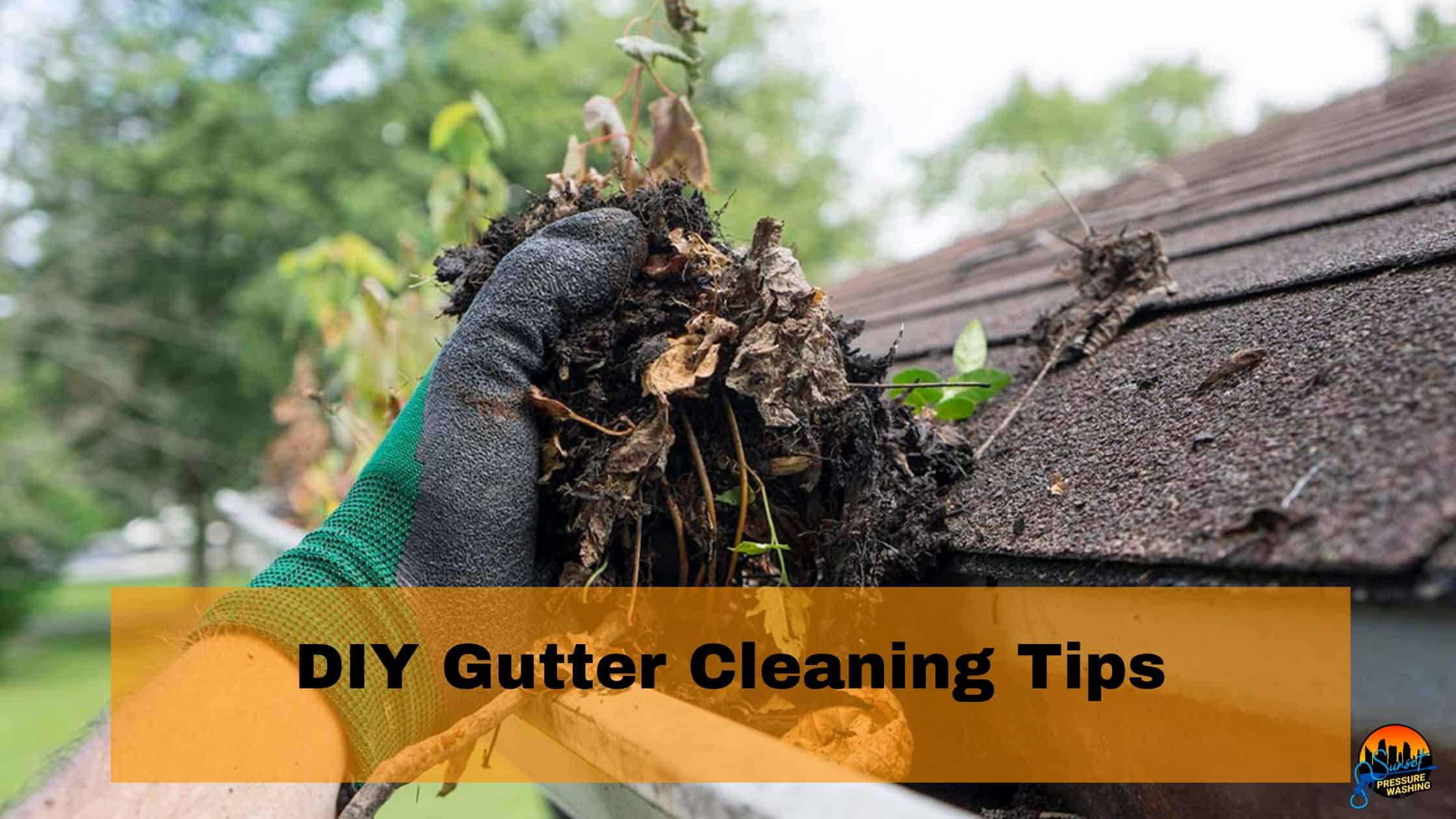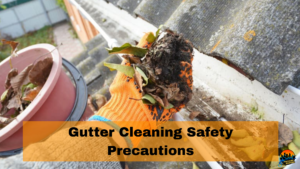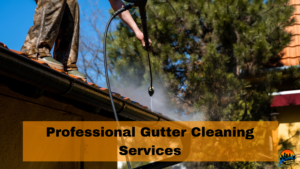
DIY Gutter Cleaning Tips
Maintaining clean gutters is essential for protecting your home from water damage. Here’s a comprehensive guide to DIY gutter cleaning, including safety tips, tools needed, and techniques. In the end, we’ll introduce a professional option for those who prefer it.
Safety First
When it comes to DIY gutter cleaning, safety should always be your top priority. Here are some key safety tips to ensure that your gutter cleaning experience is both effective and safe:
Use a Sturdy Ladder:
Always choose a stable and sturdy ladder for gutter cleaning. Ensure it’s on solid ground and, if possible, use a ladder stabilizer for added safety.
Ladder Safety:
Never overreach while on the ladder. Keep your hips within the ladder’s side rails and have someone hold the ladder at the bottom for extra stability.
Wear Proper Gear:
Protect yourself with gloves to prevent cuts from sharp debris or metal edges. Safety goggles are also crucial to protect your eyes from dirt, debris, or splashing water.
Check Weather Conditions:
Avoid cleaning your gutters in inclement weather. Wet roofs and high winds can make ladder use dangerous.
Beware of Power Lines:
Be cautious around overhead power lines. Ensure that your ladder and tools do not come into contact with them.
Take Regular Breaks:
If you’re not used to working on a ladder, you might underestimate how tiring it can be. Take breaks to prevent fatigue, which can lead to accidents.
Use the Right Tools:
Equip yourself with proper tools like a gutter scoop, which can make the job easier and reduce the risk of injury.
Stay Hydrated:
Especially in warm weather, ensure you stay hydrated to prevent dizziness or lightheadedness while on the ladder.
Know Your Limits:
If you’re not comfortable with heights or don’t feel stable on a ladder, it’s best to call professionals. The risk is not worth the reward in such cases.
Choose the Right Tools
Having the correct tools at your disposal is crucial for efficient and safe gutter cleaning. Here’s a list of essential tools that can help make your DIY gutter cleaning project more manageable and effective:
Sturdy Ladder:
A reliable, sturdy ladder is non-negotiable. For most homes, an extendable ladder will work best. If you have a two-story house, you may need a taller ladder.
Gutter Scoop or Garden Trowel:
These tools are perfect for scooping out leaves, twigs, and debris from your gutters. A plastic scoop is gentle on your gutters, reducing the risk of damage.
Heavy-Duty Gloves:
Gloves protect your hands from sharp objects, insects, and dirty water. Thick, suede-type gloves are ideal as they are waterproof and puncture-resistant.
Bucket or Plastic Tarp:
A bucket can be used to collect debris, or you can lay a tarp on the ground below where you’re working to catch the mess.
Garden Hose with Spray Nozzle:
A hose is necessary for flushing out the gutters and downspouts. A spray nozzle will give you control over water pressure and direction.
Leaf Blower or Pressure Washer (Optional):
For a quicker cleaning process, a leaf blower can be used to clear dry leaves and debris. A pressure washer can be effective but use it cautiously to avoid damaging the gutters.
Safety Goggles:
To protect your eyes from debris, bugs, and dirt, always wear safety goggles.
Ladder Stabilizer (Optional):
If you’re working on uneven ground or want extra safety, a ladder stabilizer can be a great addition.
Extension Pole (Optional):
For hard-to-reach areas, an extension pole can be useful, especially when attached to a gutter cleaning tool or spray nozzle.
Non-Slip Shoes:
Shoes with good grip are essential to prevent slips and falls, especially if you’re climbing up a ladder.
Best Time for Cleaning
Choosing the right time to clean your gutters is as important as having the right tools. Proper timing can prevent potential damage and make the cleaning process more effective. Here are some guidelines to help you determine the best time for gutter cleaning:
Twice a Year Schedule:
Generally, it’s recommended to clean your gutters at least twice a year – once in late spring and again in early fall. This timing helps in managing the debris from seasonal changes.
Post-Fall Cleaning:
Cleaning gutters after the leaves have fallen in autumn is crucial. This prevents water from freezing in clogged gutters during winter, which can lead to ice dams and potential damage.
Spring Cleaning:
Late spring cleaning ensures that winter storms haven’t clogged your gutters with debris. This also prepares them for heavier spring rains.
After Severe Weather:
If you’ve experienced severe weather, like heavy storms or winds, it’s wise to check and clean your gutters. Storms can bring down a lot of debris that may clog your gutters.
Consider Your Surroundings:
If you have a lot of trees around your house, especially pine trees which shed needles all year round, you may need to clean your gutters more frequently.
Dry Weather:
Choose a day with good, dry weather for cleaning. Wet conditions not only make the job messier but also more dangerous, especially when working on a ladder.
Removing Debris
Effectively removing debris from your gutters is a crucial step in the maintenance process. Here’s a step-by-step guide to ensure you do it efficiently and safely:
Start Near the Downspout:
Begin your cleaning near the downspout and gradually work your way along the gutter. This approach allows you to clear the way for debris to be flushed out easily.
Use a Gutter Scoop or Trowel:
Scoop out the debris using a gutter scoop or a garden trowel. These tools are effective in removing compacted leaves, twigs, and sediment.
Be Gentle:
While scraping the debris, be gentle to avoid damaging the gutter. Aluminum gutters, in particular, can dent or bend if too much force is applied.
Environmental Considerations
- Protect Plant Life and Water Sources: Cover plants and grass with a tarp or water them thoroughly before and after chemical application to dilute any potential chemical exposure. Prevent runoff from entering storm drains or water bodies.
- Use Eco-Friendly Chemicals When Possible: Opting for biodegradable and environmentally friendly chemicals can reduce the potential harm to the environment.
Collect the Debris:
Use a bucket to collect the debris or lay a tarp on the ground beneath your work area. This makes cleanup easier and protects your lawn and garden.
Check for Clogs in Downspouts:
Ensure that downspouts are not clogged. Sometimes, debris can become lodged at the entrance or in the middle of downspouts.
Use Your Hands for Large Debris:
For larger pieces like leaves and twigs, it’s often easier and more effective to use your hands (while wearing gloves). This method can prevent damaging the gutters and allows for a more thorough clean.
Be Thorough:
Make sure to remove as much debris as possible. Leftover debris can quickly lead to clogs when the next rain comes.
Work in Sections:
If your gutters are long, work in manageable sections to ensure each part is thoroughly cleaned before moving on.
Dispose of Debris Properly:
Once you’ve collected all the debris, dispose of it properly. Composting is a great option for organic materials like leaves and twigs.
Safety Reminder:
Always keep your safety in mind. Move the ladder frequently instead of overreaching, and avoid leaning over the gutters to prevent falls.
Flushing the Gutters
After you’ve removed the solid debris, the next crucial step in gutter maintenance is flushing them out. This process helps clear any remaining small debris and checks for proper water flow and leaks. Here’s how to do it effectively:
Use a Garden Hose:
Equip your hose with a nozzle that allows you to control the water pressure. Start with a moderate flow to avoid damaging the gutters.
Begin at the Farthest Point:
Start flushing the gutters from the end opposite the downspout. This helps in moving any small debris towards the downspout and out of the system.
Ensure Steady Water Flow:
Move the hose along the gutter, ensuring the water flows steadily towards the downspout. Watch for how the water drains, noting any backups or slow-draining spots, which could indicate a clog.
Check for Leaks:
As you flush the gutters, keep an eye out for any leaks or holes in the gutters. Small leaks can often be repaired, but larger issues may require professional attention.
Flush Downspouts:
Make sure to thoroughly flush the downspouts. If water backs up out of the top of the downspout, there may be a blockage. A plumber’s snake can be helpful in clearing these clogs.
Use a Pressure Washer (Optional):
For extremely dirty gutters, you may consider using a pressure washer, but be cautious as high pressure can damage gutters or your home’s siding.
Safety Reminder:
Always be mindful of your safety, especially when moving and repositioning your ladder. Avoid leaning over the gutters and keep a balanced stance.
Check the Ground Drainage:
Ensure that the water exiting the downspouts is draining properly away from your home’s foundation. Poor drainage can lead to foundation issues.
Be Consistent:
Flushing should be part of your regular gutter maintenance routine. Regular flushing can prevent build-up and reduce the likelihood of clogs.
Seek Help for Persistent Issues:
If you encounter persistent clogs or drainage issues, it may be time to consult a professional. Some problems may be beyond the scope of DIY solutions.
Checking for Repairs
Regular gutter maintenance isn’t just about cleaning; it’s also crucial to inspect your gutters for any needed repairs. Detecting and addressing these issues early can prevent more significant problems and costly repairs down the line. Here’s how to effectively check your gutters for repairs:
Look for Visible Damage:
As you clean, keep an eye out for signs of visible damage such as cracks, holes, rust, or dents. These can impair the functionality of your gutters.
Check for Sagging Sections:
Gutters should be firmly attached to your home. If you notice any sagging sections, it may indicate weakened fasteners or a damaged fascia board.
Inspect Seams and Joints:
Pay special attention to the seams and joints of your gutters. Leaks often occur here and may need resealing or patching.
Test Downspout Integrity:
Make sure downspouts are firmly attached and not corroded. They should extend several feet away from your home’s foundation for proper drainage.
Check for Gutter Guard Damage:
If you have gutter guards installed, check them for damage or clogging. Damaged guards can compromise the effectiveness of your gutter system.
Look for Water Marks or Damage on Walls:
Water marks or damage underneath the gutters indicate overflowing or leaking, suggesting that repairs are necessary.
Seal Small Leaks:
Use a gutter sealant to repair small leaks. Make sure the gutter is dry and clean before applying the sealant.
Replace Worn or Damaged Parts:
Sometimes, parts of your gutter system may be beyond repair and need replacement. This includes sections of gutter, downspouts, brackets, or hangers.
Tighten Fasteners and Hangers:
Ensure that all fasteners and hangers are tight and secure. Loose hardware can lead to sagging or detached gutters.
Consult a Professional for Major Repairs:
If you’re unsure about the extent of the damage or how to repair it, it’s best to consult a professional. They can provide a thorough inspection and expert repairs.
Installing Gutter Guards
Installing gutter guards is a proactive step to reduce the amount of debris that accumulates in your gutters. This can significantly decrease the frequency of gutter cleanings and protect your home from water-related damages. Here’s a guide to installing gutter guards:
Choose the Right Type of Gutter Guard:
There are several types of gutter guards, including mesh screens, foam inserts, and surface-tension guards. Research and choose one that suits your home’s environment and gutter type.
Measure Your Gutters:
Before purchasing gutter guards, measure the length and width of your gutters to ensure you buy enough material to cover the entire system.
Clean and Inspect Your Gutters:
Before installing gutter guards, thoroughly clean your gutters and conduct any necessary repairs. Gutter guards should be installed on clean, damage-free gutters.
Read Installation Instructions:
Each type of gutter guard may have a different installation process. Read and understand the manufacturer’s instructions before beginning.
Trim Gutter Guards to Size:
If the gutter guards don’t perfectly fit your gutters, you may need to trim them to size using appropriate tools like tin snips or a saw, depending on the material.
Install According to Manufacturer’s Guidelines:
Some guards snap onto the gutters, while others may require special fasteners or adhesives. Follow the specific installation steps provided for your chosen guards.
Ensure Proper Alignment and Fit:
As you install, ensure that the gutter guards are aligned properly and fit securely. Poorly installed guards can cause more problems than they solve.
Check for Water Flow:
After installation, it’s a good idea to run water through the gutters to ensure that the guards allow proper water flow and don’t cause overflow.
Maintenance of Gutter Guards:
While gutter guards significantly reduce the need for cleaning, they’re not entirely maintenance-free. Periodically check and clean them as needed.
Consider Professional Installation:
If you’re not comfortable with DIY installation, consider hiring professionals. They can ensure that the guards are installed correctly and efficiently.
Regular Maintenance
Consistent and regular maintenance of your gutters is vital to ensure they function correctly and protect your home from water damage. Here’s a guide to maintaining your gutter system effectively:
Biannual Cleanings:
Plan to clean your gutters at least twice a year, typically in the spring and fall. This helps to avoid blockages and ensures that your gutters are ready for seasonal weather changes.
Inspect After Storms:
After heavy storms, do a quick check to ensure your gutters are not clogged with fallen leaves, branches, or other debris. Storms can significantly increase the amount of debris in your gutters.
Check for Leaks and Misalignments:
Regularly inspect your gutters for leaks, holes, and misalignments. Early detection of these issues can prevent more significant problems later.
Ensure Proper Slope:
Your gutters should have a slight slope towards the downspouts for effective water flow. Periodically check that this slope is maintained to avoid water pooling.
Keep an Eye on Downspouts:
Make sure the downspouts are directing water away from your home’s foundation. Adjust the downspout extenders if necessary.
Trim Tree Branches:
Overhanging tree branches can drop leaves and debris into your gutters and should be trimmed back to minimize this.
Regularly Check Gutter Guards:
If you have gutter guards installed, don’t forget to check and clean them regularly. They can accumulate debris over time, which can affect their functionality.
Repair Small Issues Promptly:
Addressing minor repairs immediately can prevent them from escalating into major problems. This includes tightening fasteners, patching small holes, or reattaching loose sections.
Document Your Maintenance:
Keep a record of your gutter maintenance and repairs. This documentation can be useful for future reference or if you ever decide to sell your home.
Professional Inspections:
When to Call Professionals
While many aspects of gutter maintenance can be handled through DIY efforts, there are situations where calling in professional gutter cleaning and repair services is the best course of action. Understanding when to seek professional help can save you time, ensure safety, and provide peace of mind. Here are scenarios when you should consider calling the professionals:
Complex Repairs:
While many aspects of gutter maintenance can be handled through DIY efforts, there are situations where calling in professional gutter cleaning and repair services is the best course of action. Understanding when to seek professional help can save you time, ensure safety, and provide peace of mind. Here are scenarios when you should consider calling the professionals:
Height and Safety Concerns:
If your home is particularly tall or your roofline is complex, it’s safer to hire professionals. They are equipped and trained to safely handle gutter maintenance on high or difficult-to-reach rooftops.
Uncertain about a Problem:
If you’re unsure about a potential issue or don’t know how to fix it, professionals can provide a reliable diagnosis and solution. It’s better to get expert advice than to risk exacerbating the problem.
Lack of Time or Tools:
If you don’t have the time, tools, or inclination to do the job yourself, hiring a professional can ensure that your gutters are well-maintained without inconvenience to you.
After Severe Weather Events:
In the aftermath of severe weather, such as heavy storms or extreme winters, it’s a good idea to get a professional inspection to ensure no hidden damages have occurred.
Installation of Gutter Guards or New Gutters:
If you’re considering installing gutter guards or replacing your gutter system, professional installation guarantees proper fit and function, which is crucial for long-term performance.
Regular Maintenance Program:
Professionals often offer regular maintenance programs where they check and clean your gutters periodically. This can be a convenient way to ensure continuous upkeep without worrying about scheduling or forgetting.
Quality Assurance:
Professionals not only fix immediate issues but can also provide tips on how to maintain your gutters and recommend improvements for better functionality.
Insurance and Warranty:
Professionals are typically insured, which means any accidental damage during their service is covered. Plus, their work often comes with a warranty, giving you added security.
Peace of Mind:
Knowing that experienced professionals are handling your gutter maintenance can provide peace of mind, especially if gutter cleaning is a task you find particularly daunting or risky.
Consider a Professional Gutter Cleaning Service
DIY gutter maintenance is a viable option for many, the benefits of hiring professional gutter cleaning services cannot be overstated. Professionals like those at Sunset Pressure Wash offer the expertise, efficiency, and safety that DIY efforts may not always match. We are equipped with the right tools and techniques to handle various gutter issues, from standard cleaning to complex repairs, ensuring your gutter system functions optimally year-round.
Choosing a professional service also offers peace of mind, knowing that your gutters are in expert hands. Whether you’re dealing with hard-to-reach areas, complex gutter systems, or simply lack the time for maintenance, a service like Sunset Pressure Wash can provide a convenient and effective solution. For more information on the benefits of professional gutter maintenance and the tools used, you can visit Sunset Pressure Wash. Our experience and dedication to quality service make them an excellent choice for your gutter maintenance needs.






